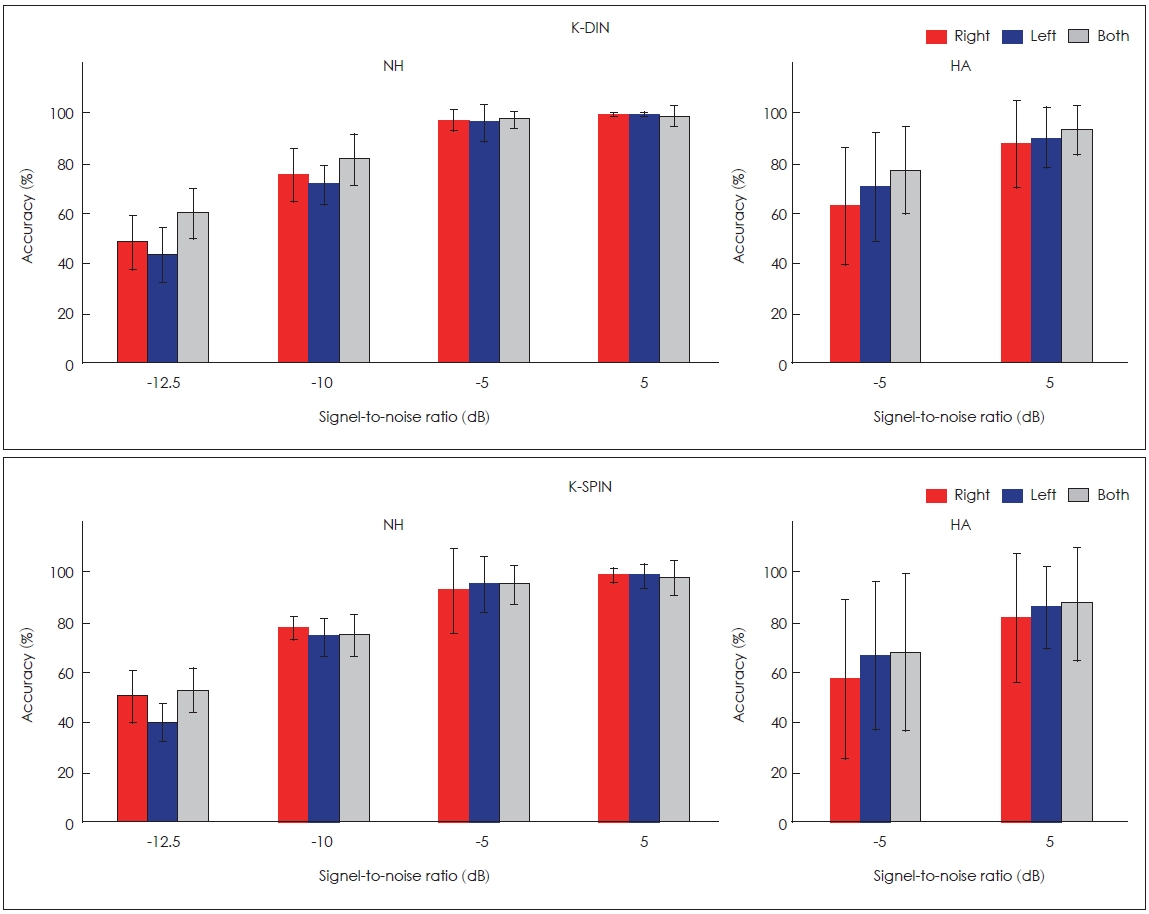1. George EL, Zekveld AA, Kramer SE, Goverts ST, Festen JM, Houtgast T. Auditory and nonauditory factors affecting speech reception in noise by older listeners. J Acoust Soc Am 2007;121:2362–75.


2. Theunissen M, Swanepoel de W, Hanekom J. Sentence recognition in noise: variables in compilation and interpretation of tests. Int J Audiol 2009;48:743–57.


3. Nilsson M, Soli SD, Sullivan JA. Development of the hearing in noise test for the measurement of speech reception thresholds in quiet and in noise. J Acoust Soc Am 1994;95:1085–99.


4. Killion MC, Niquette PA, Gudmundsen GI, Revit LJ, Banerjee S. Development of a quick speech-in-noise test for measuring signal-tonoise ratio loss in normal-hearing and hearing-impaired listeners. J Acoust Soc Am 2004;116:2395–405.


5. Kollmeier B, Warzybok A, Hochmuth S, Zokoll MA, Uslar V, Brand T, et al. The multilingual matrix test: principles, applications, and comparison across languages: a review. Int J Audiol 2015;54 Suppl 2:3–16.


6. An LJ, Kim JS, Pae SY. The study on developing a test of speech perception in noise. Korean J Audiol 2002;6:118–27.
7. Kalikow DN, Stevens KN, Elliott LL. Development of a test of speech intelligibility in noise using sentence materials with controlled word predictability. J Acoust Soc Am 1977;61:1337–51.


8. Moon SK, Mun HA, Jung HK, Soli SD, Lee JH, Park K. Development of sentences for Korean hearing in noise test (KHINT). Korean J Otolaryngol-Head Neck Surg 2005;48:724–8.
9. Kim KH, Lee JH. Evaluation of the Korean matrix sentence test: verification of the list equivalence and the effect of word position. Audiol Speech Res 2018;14:100–7.

10. Kaandorp MW, Smits C, Merkus P, Goverts ST, Festen JM. Assessing speech recognition abilities with digits in noise in cochlear implant and hearing aid users. Int J Audiol 2015;54:48–57.


12. Smits C, Kapteyn TS, Houtgast T. Development and validation of an automatic speech-in-noise screening test by telephone. Int J Audiol 2004;43:15–28.


13. Smits C, Theo Goverts S, Festen JM. The digits-in-noise test: assessing auditory speech recognition abilities in noise. J Acoust Soc Am 2013;133:1693–706.


14. Hall JS. The development of a new English sentence in noise test and an English number recognition test [dissertation]. Southampton: University of Southampton;2006.
15. Watson CS, Kidd GR, Miller JD, Smits C, Humes LE. Telephone screening tests for functionally impaired hearing: current use in seven countries and development of a US version. J Am Acad Audiol 2012;23:757–67.


16. Zokoll MA, Wagener KC, Brand T, Buschermöhle M, Kollmeier B. Internationally comparable screening tests for listening in noise in several European languages: the German digit triplet test as an optimization prototype. Int J Audiol 2012;51:697–707.


17. Jansen S, Luts H, Dejonckere P, van Wieringen A, Wouters J. Exploring the sensitivity of speech-in-noise tests for noise-induced hearing loss. Int J Audiol 2014;53:199–205.


18. Zhang H, Wang S, Wang L, Chen J, Yue P, Guo L, et al. Digital recording and equivalent evaluation of Mandarin speech test materials. Journal of Clinical Otorhinolaryngology 2006;20:1011–5.

19. Ozimek E, Kutzner D, Sęk A, Wicher A. Development and evaluation of Polish digit triplet test for auditory screening. Speech Commun 2009;51:307–16.

20. Warzybok A, Zokoll MA, Kollmeier B. Development and evaluation of the Russian digit triplet test. Acta Acust united Ac 2016;102:714–24.

21. Pérez-González P, Gorospe JM, Lopez-Poveda EA. A Castilian Spanish digit triplet identification test for assessing speech intelligibility in quiet and in noise. Revista de acústica 2013;44:13–24.
25. Akeroyd MA, Arlinger S, Bentler RA, Boothroyd A, Dillier N, Dreschler WA, et al. International collegium of rehabilitative audiology (ICRA) recommendations for the construction of multilingual speech tests. ICRA working group on multilingual speech tests. Int J Audiol 2015;54 Suppl 2:17–22.

26. Neumann K, Baumeister N, Baumann U, Sick U, Euler HA, Weissgerber T. Speech audiometry in quiet with the Oldenburg sentence test for children. Int J Audiol 2012;51:157–63.


27. Giguère C, Lagacé J, Ellaham NN, Pichora-Fuller MK, Goy H, Bégin C, et al. Development of the Canadian digit triplet test in English and French. J Acoust Soc Am 2020;147:EL252


28. Yu J, Chun H, Song CG, Han W. Case study of speech perception enhancement in hearing-impaired adult by auditory training program of mobile device. Audiol 2014;10:158–68.













